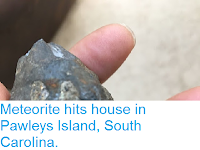The roof of a shop in the city of Paarl in Western Cape Province, South Africa, was damaged by a meteorite earlier this week. The shop's owner, Fagrie Allie, was closing up the premises when he heard a loud crash, which he initially thought was caused by an intruder. When he investigated the noise he found hole which penetrated the metal roof of the property and ceiling beneath it, with fragments of an unfamiliar rock inside. He then contacted the Geology Department at the University of Cape Town, who confirmed the rocks were pieces of a meteorite.
Shop owner Fagrie Allie with fragments of the Paarl Meteorite. Henk Kruger/ANA Pictures.
Meteorites that fall to the ground are typically chunks of larger rocks
that have exploded in the upper atmosphere due to heat from friction
caused by the velocity from their orbit which far exceeds that caused by
gravitational falling. Meteorites that fall to Earth are a byproduct of
such explosions,
fragments of rock from the interior of the asteroid that fall to Earth
under gravity, which is not enough to heat them. Such meteorites
typically have fire-blackened, melted, exteriors, a result of the
initial heating
and explosion, but this initial heat is usually lost through convection
into the interior of the meteorite (which, having come from space, is
typically only a few degrees above absolute zero when it begins its
journey through the atmosphere), so that the object is cold (usually
very cold) when it reaches the ground.
See also...
Follow Sciency Thoughts on Facebook.







